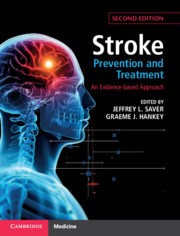Book contents
- Stroke Prevention and Treatment
- Stroke Prevention and Treatment
- Copyright page
- Dedication
- Contents
- Contributors
- Preface
- Part I Foundations
- Part II Systems of Care
- Part III Acute Treatment of Ischaemic Stroke and Transient Ischaemic Attack
- Chapter 5 Supportive Care during Acute Cerebral Ischaemia
- Chapter 6 Reperfusion of Ischaemic Brain by Intravenous Thrombolysis
- Chapter 7 Reperfusion of the Ischaemic Brain by Endovascular Thrombectomy and Thrombolysis
- Chapter 8 Collateral Flow Enhancement: Blood Pressure Lowering and Alteration of Blood Viscosity
- Chapter 9 Acute Antiplatelet Therapy for the Treatment of Ischaemic Stroke and Transient Ischaemic Attack
- Chapter 10 Acute Anticoagulant Therapy for the Treatment of Acute Ischaemic Stroke and Transient Ischaemic Attack
- Chapter 11 Treatment of Brain Oedema
- Chapter 12 Neuroprotection for Acute Brain Ischaemia
- Part IV Acute Treatment of Haemorrhagic Stroke
- Part V Prevention
- Part VI Stroke Rehabilitation and Recovery
- Index
- References
Chapter 6 - Reperfusion of Ischaemic Brain by Intravenous Thrombolysis
from Part III - Acute Treatment of Ischaemic Stroke and Transient Ischaemic Attack
Published online by Cambridge University Press: 15 December 2020
- Stroke Prevention and Treatment
- Stroke Prevention and Treatment
- Copyright page
- Dedication
- Contents
- Contributors
- Preface
- Part I Foundations
- Part II Systems of Care
- Part III Acute Treatment of Ischaemic Stroke and Transient Ischaemic Attack
- Chapter 5 Supportive Care during Acute Cerebral Ischaemia
- Chapter 6 Reperfusion of Ischaemic Brain by Intravenous Thrombolysis
- Chapter 7 Reperfusion of the Ischaemic Brain by Endovascular Thrombectomy and Thrombolysis
- Chapter 8 Collateral Flow Enhancement: Blood Pressure Lowering and Alteration of Blood Viscosity
- Chapter 9 Acute Antiplatelet Therapy for the Treatment of Ischaemic Stroke and Transient Ischaemic Attack
- Chapter 10 Acute Anticoagulant Therapy for the Treatment of Acute Ischaemic Stroke and Transient Ischaemic Attack
- Chapter 11 Treatment of Brain Oedema
- Chapter 12 Neuroprotection for Acute Brain Ischaemia
- Part IV Acute Treatment of Haemorrhagic Stroke
- Part V Prevention
- Part VI Stroke Rehabilitation and Recovery
- Index
- References
Summary
Intravenous thrombolytic therapy (IV) with recombinant tissue-plasminogen activator (alteplase; 0.9 mg/kg over 1h) is beneficial for acute ischaemic stroke patients with potentially disabling neurological deficits, and without contraindications, when started =4.5h of onset. Benefit is time-dependent: among 1000 patients, IVT =3h lessen long-term disability in 178 patients, between 3-4.5h in 66. IVT under 4.5h is associated with an increase in symptomatic haemorrhage, but not an increase in death or severe disability. Based on trial evidence, IVT =3h is strongly endorsed, and between 3-4.5 hours moderately endorsed, by guidelines on 5 continents. Benefit is evident in patients under and over age 80, and in patients with up to moderate, but not extensive (more than 100 cc), early ischaemic changes on initial CT or MRI. IVT is also beneficial for patients =4.5h after onset with substantial salvageable tissue on penumbral CT or MR imaging. Systems of care should be optimized to start IVT =60m, and optimally =30m, after ED arrival. Large-scale trials are needed to further enhance IVT, testing: faster treatment start in mobile stroke units (mobile CT ambulances): fibrinolytic agent and concomitant lytic-enhancing combinations; bridging neuroprotection and collateral enhancement; and the optimal way to combine intravenous thrombolytic therapy and endovascular mechanical thrombectomy.
Keywords
- Type
- Chapter
- Information
- Stroke Prevention and TreatmentAn Evidence-based Approach, pp. 98 - 126Publisher: Cambridge University PressPrint publication year: 2020



